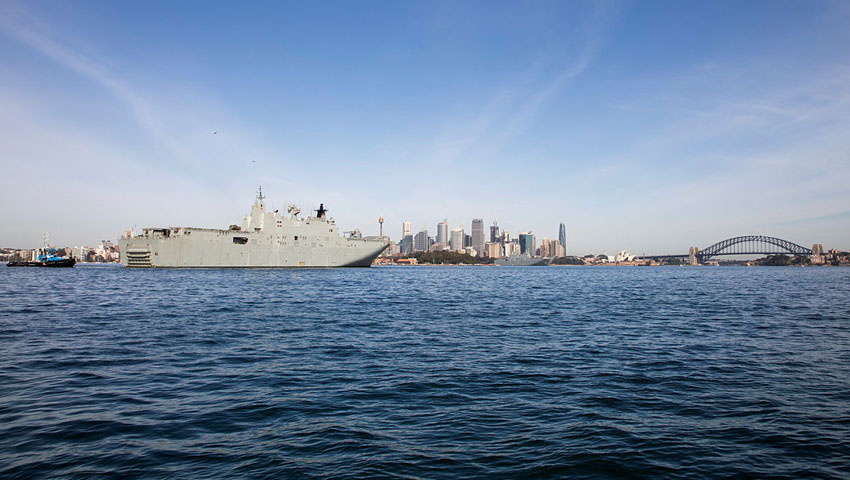The Royal Australian Navy’s flagship, HMAS Canberra, has returned to Sydney after a nearly three-month deployment comprised of multilateral training exercises as part of a task group, maritime integration with Army elements, and a successful search and rescue in the Pacific.
HMAS Canberra sailed from Sydney in mid June for a period of Force Integration Training with other ships in the fleet before leaving Australia as part of a five-ship task group conducting maritime exercises with other nations in south-east Asia and the Pacific.
Commanding Officer Captain Terry Morrison commended the resilience and hard work of the ship’s company and embarked forces during a busy deployment without port visits because of COVID-19 restrictions.
"Our officers, sailors and embarked Army members all kept positive attitudes and showed their commitment to maintaining our skills and proving our ship’s capabilities. We can be proud of our professionalism in engagement with other navies, including the United States, Japan, and Singapore, in which we practised interoperability and shared knowledge for the support and security of our region," CAPT Morrison explained.
In Micronesia, Canberra and its embarked Army helicopter crews from 1st Aviation Regiment were instrumental in a search and rescue operation, which successfully located three men who had been missing at sea for nearly three days.
While traversing the Solomon Islands, the ship held a memorial marking the anniversary of the sinking of her namesake, HMAS Canberra (I), in a WWII battle.
The Australian Defence Force is embarking upon a regional deployment to conduct exercises within south-east Asia and Hawaii over the coming months.
The Regional Presence Deployment 2020 demonstrates Australia’s commitment to sustaining strong and positive defence relationships with regional nations as well as the security and stability of the Indo-Pacific region.
As part of the Regional Presence Deployment 2020, the ADF worked closely with regional partners, including the US and Japan, to promote regional security and stability, prior to attending and participating in the world's largest naval warfare exercise RIMPAC 2020 off the coast of Hawaii.
After arriving at RIMPAC, the Royal Australian Navy contingent (comprising of HMA Ships Canberra, Hobart, Stuart, Arunta and Sirius) joined forces with foreign counterparts to conduct replenishment at sea, aviation operations, maritime manoeuvres and communications drills.
This included the USS Ronald Reagan Carrier Strike Group, covering the US Navy’s guided-missile cruiser USS Antietam and guided-missile destroyer USS Mustin, as well as the Japan Maritime Self-Defense Force’s Akizuki Class destroyer JS Teruzuki.
The RAAF joined RIMPAC soon after, with over 150 RAAF personnel and a host of service aircraft deployed to the US territory of Guam. The Air Task Unit is comprised of some of the service's most valuable and high-tech assets: F/A-18A Hornets, EA-18G Growlers, an E-7A Wedgetail and a KC-30A Multi-Role Tanker Transport.
The Regional Presence Deployment demonstrates Australia’s commitment to sustaining strong and positive defence relations with regional nations as well as the security and stability of the Indo-Pacific region.
HMAS Canberra is the lead ship of the two ship Canberra Class amphibious assault ships, otherwise known as a landing helicopter dock (LHD), based on the Buque de Proyección Estratégica (Strategic Projection Ship) design by Spanish shipbuilders Navantia.
At 27,000 tonnes, the LHDs are the largest ships ever constructed for the RAN and are being built by contractors BAE Systems Australia and Navantia.
The ships will provide the ADF with one of the most capable and sophisticated air-land-sea amphibious deployment systems in the world.
Canberra is capable of conducting large-scale humanitarian and disaster relief missions. The medical facility is of a size and scope that would rival some regional hospitals, equipped with two operating theatres, an eight-bed critical care unit, and a variety of low and medium dependency beds.
In addition, the medical facility has dedicated areas to accommodate pathology and radiology services, x-ray, pharmacy and dental facilities.
Canberra carries the pennant number L02 and not L01, even though it was the first of its class to be built. HMAS Adelaide (III) carries pennant number L01. This is so the two ships’ pennant numbers will conform to the convention adopted with their namesakes in the Adelaide Class.
HMAS Canberra was commissioned and joined the RAN fleet in an official ceremony at Fleet Base East, Sydney, on 28 November 2014. In March 2015, HMAS Canberra was formally designated the flagship of the RAN.









